- Review:
- A Java program consists of
one or more classes
- A class contains
one or more methods
- A method contains
one or more statements
- A statement is the smallest unit of execution in a Java program
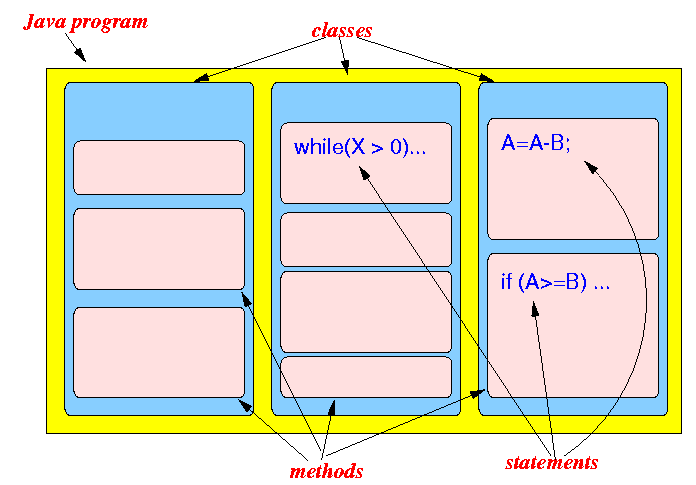
We will explore these concept further in this webpage.
- A Java program consists of
one or more classes
- The building blocks
discussed in this webpage:
- Statements
- Methods
- Keywords and Identifiers
- Classes
- Blocks
- Comments
- Statement:
- Statement = the smallest (unit) of execution in a Java program
(You cannot execute a portion of a statement)
A statement is like a sentence: it is the smallest unit that you write in a book.
- Examples of a statement:
System.out.println("Hello Class");
- Effect of a statement:
- A statement tells the
computer to
do something
Example:
- When the statement
System.out.println("Hello Class");
is executed, the computer will print the text "Hello Class" to the terminal
- When the statement
- A statement tells the
computer to
do something
- There are different kinds (types)
of statements in Java
- We will discuss the details of each statement in Java later in the course
- Each type of statement
follows a specific syntax
- This is similar to
the English language
- Each type of sentence
in English has its own
syntax
Example:
- An ordinary sentence follows the syntax: subject verb
- A question (sentence) follows syntax: verb subject
- This is similar to
the English language
- We will discuss the details of the syntax of each type of statement in Java later in the course
- Important facts:
- One statement can only perform
a simple operation
- One statement is
insufficient
to solve a complex problem
- A complex task can be performed by many statements
- One statement can only perform
a simple operation
- Method:
- For convenience,
you can put a number of statement
into a unit called a
method
- The method is given a unique name to identify the group of statements.
- For convenience,
you can put a number of statement
into a unit called a
method
- Example:
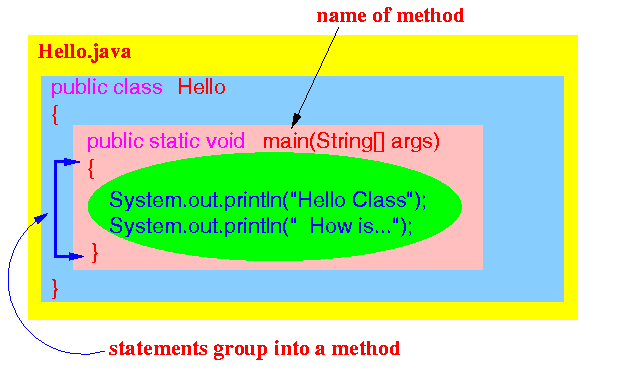
- Terminology:
- Define a method = constructing a method
- You must use
a specify syntax
to define a new method
We will discuss a simplified syntax on how to define a method here and discuss the details on how to define methods later
- Simplified syntax used to define a method:
MethodProperties METHOD_NAME( ... ) { statements contained in the method }Explanation:
- The MethodProperties
describes the properties of
the new method
- The METHOD_NAME is
the name of the method
(used for identification)
- The brackets ( ... )
contains parameters for
the method
- You have seen parameters before
if you have used a TI-83
calculator:
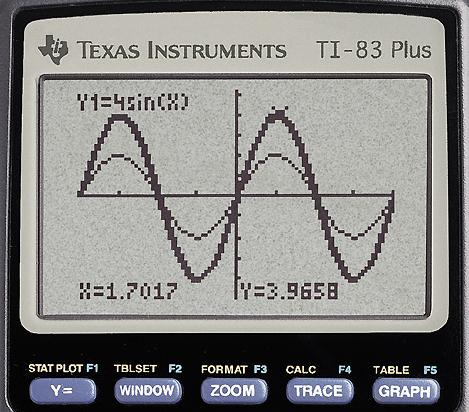
The X in the formula Y1 = 4sin(X) is a parameter
BTW, sin(..) is a method !!!
Parameters provide information to the method
- You have seen parameters before
if you have used a TI-83
calculator:
- Finally, the braces { ..... } encloses the statements
- The MethodProperties
describes the properties of
the new method
- Example:
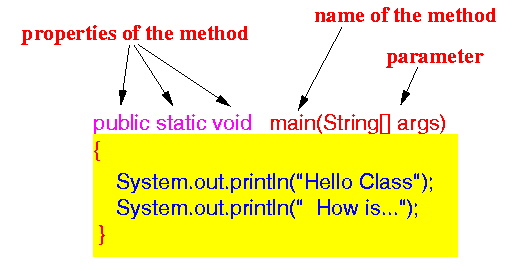
- The computer can execute a method
- A method is a larger execution unit than a (single) statement
- Computer jargon:
- Invoke a method = execute a method
- When a method is
invoked (executed), then:
- all statements contained between the braces { .... } are executed one statement at a time
- Example:
- Java program:

When the Hello.java is run using the command:
java Hellothe computer will invoke the main() method
- The execution of the
main() method
will
execute the statements contained in
the main() method
one at a time:
System.out.println("Hello Class"); System.out.println(" How is... ");
- Java program:
- Fact:
- You only have to
define a method
once
(In a method definition, you are telling the computer what it needs to do when you call that method.
You only have to instruct the computer once.)
- After you have defined a method, you can invoke the method as many times as you need/want to !!!
- You only have to
define a method
once
- Computer Science jargon:
- Body of a method =
the part of the
method definition
that is enclosed between the
braces { ... }
- Header of a method = the part of the method definition before the body of the method
Graphically explained:
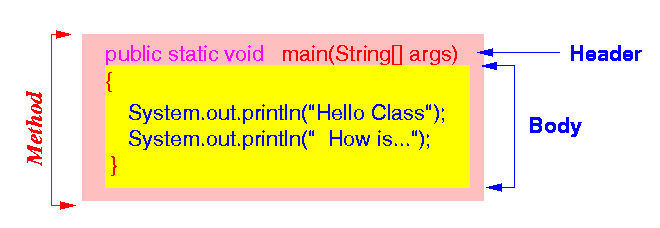
- Body of a method =
the part of the
method definition
that is enclosed between the
braces { ... }
- Note:
- When a method is executed, the statements in its body are executed
- Each programming language
has reserved a number of
words for some
specific purpose
- Keyword:
- Keyword = a reserved word in a programming language
Examples: public, static and void
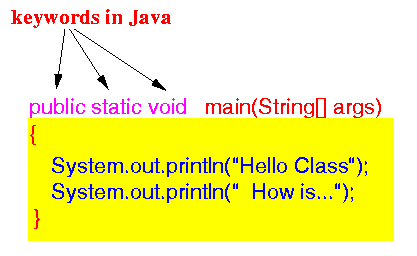
- Keywords have
special meaning in
a programming language:
- A keyword must be used for that specified purpose
Example:
- A public method
is a method that has the
highest level of accessibility
(Java allows you to define methods with more limited accessibility with the keyword private.
You will learn about this topic much later - in another course)
- Identifier:
- Identifier = a name chosen by the programmer to identify something defined inside a program
There are some rules in Java that you must follow to form the identifier name
- Rules to form the name of an identifier in Java:
- An identifier consists of
a number of characters
- There is no limit on the
number of characters
in the identifier
(but do not try using identifiers that are too long because
you will have to type it yourself...)
- The first character
of an identifier must be one of the following:
- A letter (a, b, ..., z, A, B, ..., Z), or
- The underscore character
- The subsequent characters
of an identifier must be one of the following:
- A letter (a, b, ..., z, A, B, ..., Z), or
- The underscore character, or
- A digit (0, 1, ..., 9)
- Identifiers are
case-sensitive !
- You cannot use a keyword as identifier (keywords are reserved for a specific purpose !)
- An identifier consists of
a number of characters
- Examples of correct identifiers:
age Age (is different from age) greaterCommonDivisor R2D2 radius_of_the_circle
- Examples of illegal identifiers:
3cpo (cannot start with a digit) radius-of-the-circle (cannot have minus sign in an identifier) public (cannot use a keyword !)
- Important facts:
- One method is used to perform
one complex task
- In order to solve one problem,
you may need to
perform multiple complex tasks
For each complex task, you will have to write one method to perform the task.
- The different methods
have a common purpose
- It makes sense to collect methods that serve similar purpose together.
- One method is used to perform
one complex task
- Class:
- For organizational purpose,
you can put a number of methods
into a unit called a
class
- The class is given a unique name
- For organizational purpose,
you can put a number of methods
into a unit called a
class
- You must use
a specify syntax
to define a new class
- Syntax to define
a class:
ClassProperties class CLASSNAME { methodDefinitions }Explanation:
- The ClassProperties
describes the properties of
the new class
- A word class
is a keyword
The use of this keyword tells Java that you want to define a new class
- The CLASSNAME is
an identified used as the
name of the new class
- The CLASSNAME must be
unique
(chosen by the programmer)
- The name of the class must be the same as the name of the file that contain the class
- The CLASSNAME must be
unique
(chosen by the programmer)
- The ClassProperties
describes the properties of
the new class
- Example:
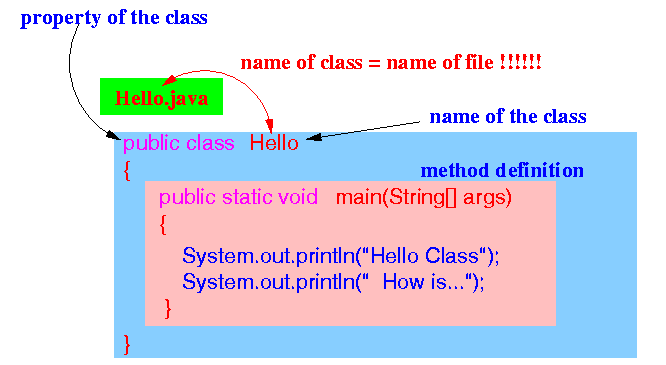
- Block:
- Block = a pair of "{" and "}" braces that groups components in a Java program together
- Example:
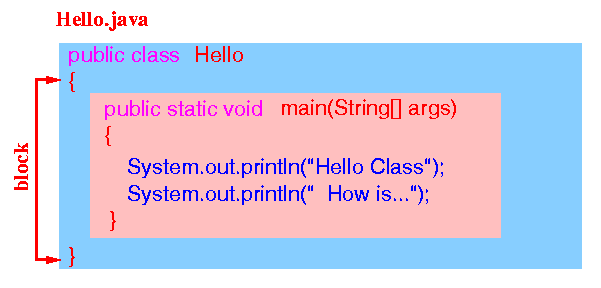
Because this block is part of a class definition, it is called a class block
- Blocks can be
nested:
one block can be
placed inside
another block
Example:
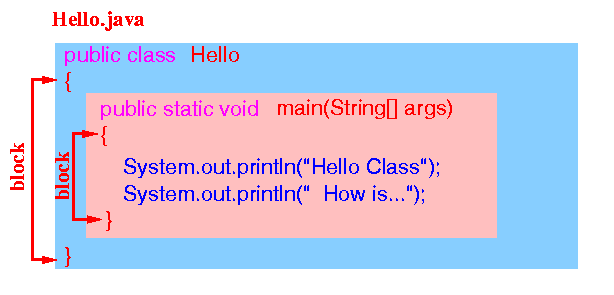
The outer block is a class block
The inner block is the body of a method and it is called a method block
- Notes:
- An opening brace "{"
must be matched
with a
closing brace "}"
Programming tip:
- Whenever you type an opening brace "{",
immediately type a closing brace "}"
on the next line
- Go back and insert the rest of the program.
- Whenever you type an opening brace "{",
immediately type a closing brace "}"
on the next line
- An opening brace "{"
must be matched
with a
closing brace "}"
- Every letter in a Java program
is case-sensitive
Meaning:
- A lower-case letter and
its corresponding upper-case letter
are counted as different
Example:
-
public and
Public are not the same.
(You can use Public as an identifier, but not public !)
-
public and
Public are not the same.
- A lower-case letter and
its corresponding upper-case letter
are counted as different
- Comment:
- Comment =
text inside a Java program
that is
ignored by the
Java compiler
- Comments are used to annotate the program to help humans understand the operation of the Java program
- Comment =
text inside a Java program
that is
ignored by the
Java compiler
- Syntax for a comment
in Java:
- Single line comment syntax:
// ... single line comment
The text on the line following the symbol // will be ignored
- Multiple lines comment syntax:
/* comment line 1 comment line 2 ... ... */All text between the comment brackets /* ..... */ will be ignored
- Single line comment syntax:
- Example:
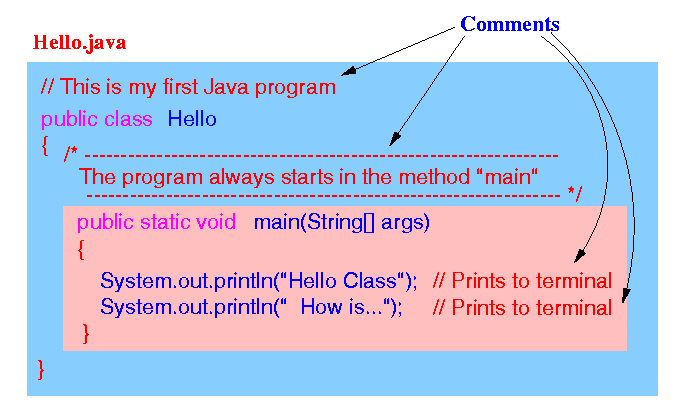
- Example Program:
(Demo above code)

- The Hello prog file with comments: click here
How to run the program:
- Right click on link and
save in a scratch directory
- To compile: javac Hello2.java
- To run: java Hello2
- The Java compiler (translator)
consider white space characters
(i.e., SPACE, TAB and New line)
as insignificant
- All that the Java compiler cares about is syntactical correctness
- Consequence:
- You can make a Java program look very ugly and it may still be syntactically correct to the Java compiler
- Example:
public class Hello2 { public static void main(String[] args) { System.out.println("Hello Class"); System.out.println(" How is everyone doing so far ?"); } }Same program with many insignificant white spaces:
public class Hello3 { public static void main (String[] args) { System.out.println ( "Hello Class"); System.out.println( " How is everyone doing so far ?"); }}(But... I had to call it Hello3 because the name Hello2 is already used)
- Example Program:
(Try it out ! It will run and print the same thing)

- Prog file: click here
How to run the program:
- Right click on link and
save in a scratch directory
- To compile: javac Hello3.java
- To run: java Hello3
- Moral of this lesson:
- Do yourself a
favor
- Don't abuse the
format-free feature of Java
- Indent your programs
properly so the
structure of the algorithm
is
easily visible
It will help you understand what the program is doing and find errors
- Do yourself a
favor
- What a Java program look like
abstractly:

- What a Java program look like
more concretely:
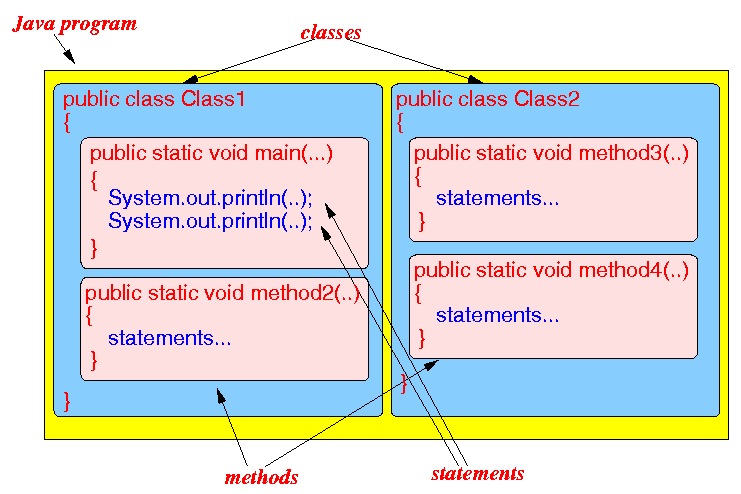
- Keyword =
a (English) word that
is reserved
for a special purpose
- Each keyword has a special meaning in Java
- Identifier =
an (artificial) name
made up by the programmer
- The (artificial) name is used to identify things defined in a java program
- Statement =
the smallest unit of execution
in Java
- Method = contains
multiple statements and
identified by a method name
which is an
identifier
- When a method is invoked, all statements contained in the method are executed
- Class = contains
methods that serve
a similar purpose
Each class is identified by a class name which is an identifier
- Syntax to define a public class:
public class CLASSNAME { (method definitions) } - Syntax to define the
main method in Java:
public static void main(String[] args) { (statements) }